Chronically tight hips not only can make certain yoga poses difficult to execute, they can also cause chronic discomfort. Although the reason varies, most people lack hip mobility because of sedentary lifestyles, past injuries or scar tissue from surgeries. Furthermore, according to certain yoga lineages, the hips are the storage center for unresolved emotions; therefore, ancient yogis believed stress and unsteady emotions manifest within the pelvic bowl, resulting in tight, stiff and immobile hip musculature.
Thanks to its elevated surface, using the BOSU for yoga hip openers allows you to stretch and perform asanas with ease. Also, the BOSU assists in bringing awareness to poses because you must engage the core to stay steady on top of the unstable surface.
If you desire more advanced, or deeper, hip openers, the elevated surface of the BOSU also allows you to deepen your practice. Therefore, the BOSU is ideal for anyone who desires an easier or more challenged practice. The poses in the following hip-opening routine should be performed in order, and each pose should be held for 30 to 60 seconds. Complete the routine with the right leg coming forward, and then repeat with the left leg forward.
Downward Facing Dog
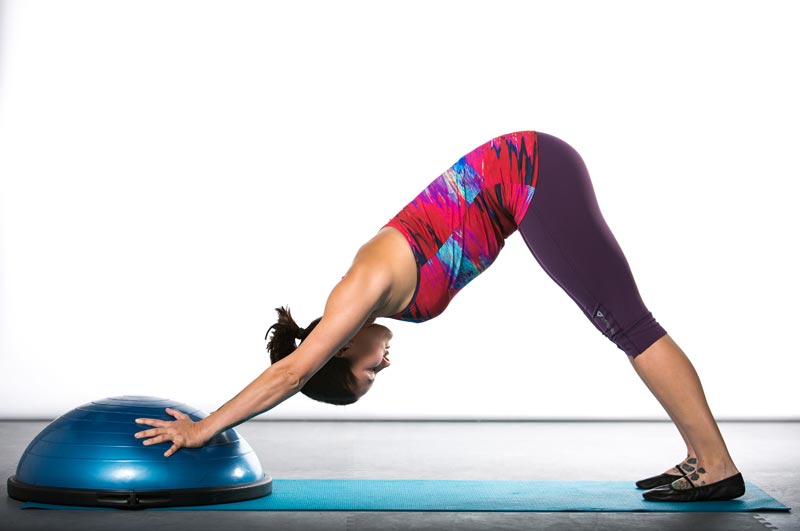
Downward facing dog promotes openness in the back of the legs. Placing your hands on the BOSU helps facilitate proper alignment in the torso, avoiding kyphosis, which many people experience. The elevation allows the heels to be firm on the ground.
How to Perform: Stand behind the BOSU and place the hands 2 to 3 inches in front the center bullseye. Keep hands shoulder-width apart. Walk the feet back and lift the hips into the air. Relax the chest and heels and focus on breathing in the front and back of the chest.
Low Lunge Variation
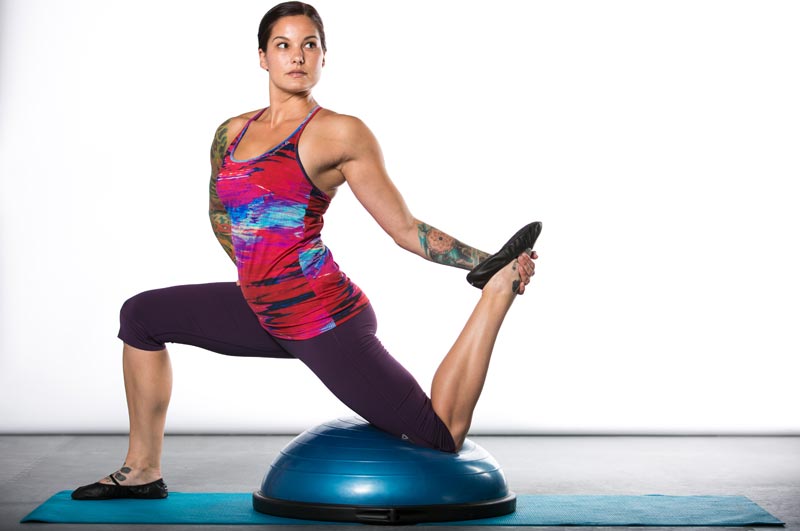
This lunge allows the body to deeply lengthen the hip flexors. Those who perform the more advanced version will find a deeper openness into the quadriceps, chest and shoulder. The BOSU allows for the back leg to open without force and makes this pose achievable for those with balance and knee issues.
How to Perform: From downward facing dog, transition the body into a plank and step the right foot forward, in front of the BOSU. Place the left knee on the dome and position the right ankle under the knee. Lunge forward toward the front leg to open a point to where the front left hip opens. To progress the exercise, bend the left knee and with the left hand reach for the left foot or ankle. The right hand can be placed on the hip to support balance.
Revolved Side Angle Pose
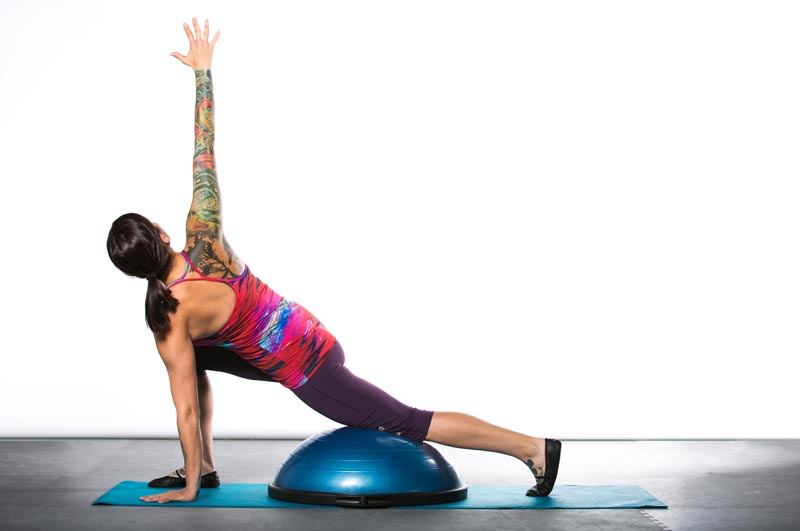
This pose allows the lateral part of the hip and external rotators to open, while also improving thoracic mobility. The BOSU assists the transition between poses, promoting better movement and balance. The BOSU allows someone to reach for the floor with more confidence as the dome is supporting the body’s weight.
How to Perform: Maintain the low lunge position from the previous pose. Place the left hand on the floor and rotate the chest toward the inner thigh. Reach the right arm over the shoulder and breathe deeply into the right open space of the rib cage.
Pigeon
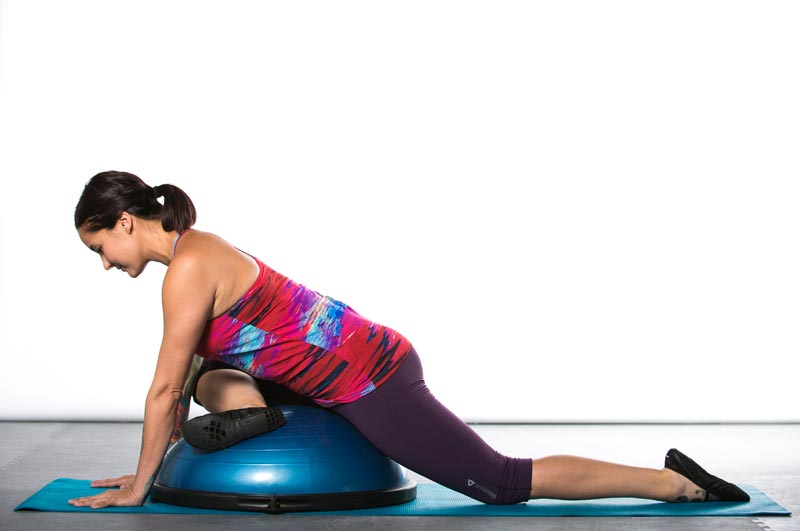
Pigeon externally rotates the leg, which lengthens the external rotators, piriformis and hamstrings. The BOSU supports the pelvis in a neutral position. On the ground, this is a challenging task for those with chronically tight hips. For those with limited flexibility, pigeon pose is sometimes unachievable with a cushioned support. The BOSU, however, meets the hips halfway.
How to Perform: From revolved side angle pose, lift the body upward and back to lay the right shin and hip on the BOSU. The shin will go slightly in front of the bullseye and the hip will lie behind the bullseye. Extend the left leg behind and rest the knee on the floor for support. For a deeper pigeon, rest the torso forward without applying weight on the front leg.
Seated Forward Straddle

This pose lengthens the muscles on the back of the legs and the gracilis of the inner thigh. When performing this exercise on the ground, people with tight hips often curve from the spine rather than hinge from the hip. The elevated surface brings awareness to hinging from the hips and allows the stretch to be more achievable.
How to Perform: Sit on top of the dome, with the hips directly on top, or about 3 inches in front of the bullseye. Place the legs into a “V” position while keeping the feet flexed. Keep the chest upright and hinge forward from the hips. Hold to the point where you feel a stretch.
Butterfly
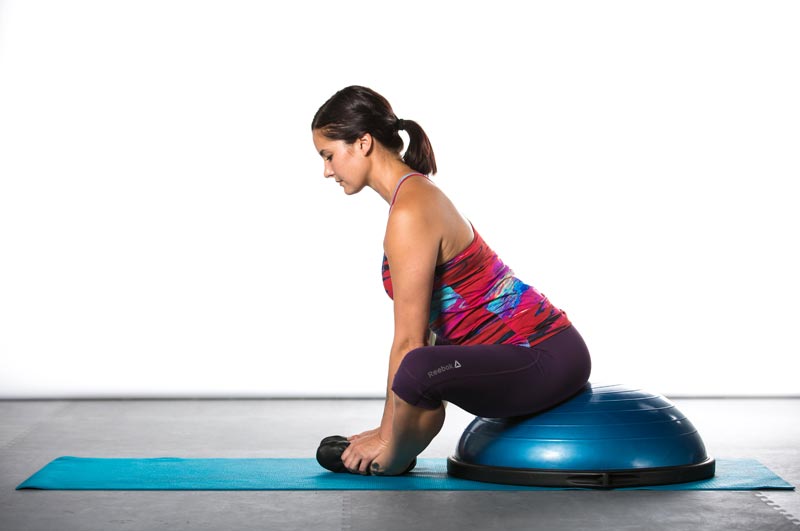
Butterfly is known for externally rotating the hips and deeply opening the inner thighs. For those with tight hips and upper backs, butterfly on the ground may curve the spine and hike the legs upward. The BOSU’s elevated surface enables the legs to open in a comfortable, non-invasive manner. The wider the knees, the more the gracilis lengthens.
How to Perform: Sit on top of the dome with the knees bent. Allow the knees to gently open to the sides while you keep the feet together. Keep the spine neutral and allow the legs to relax to the side. To increase the depth of the stretch, hinge forward while maintaining a neutral spine.
Original article and pictures take www.acefitness.org site
Комментариев нет:
Отправить комментарий